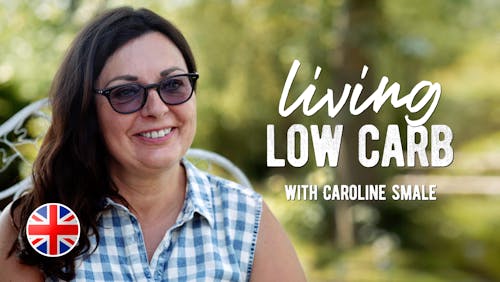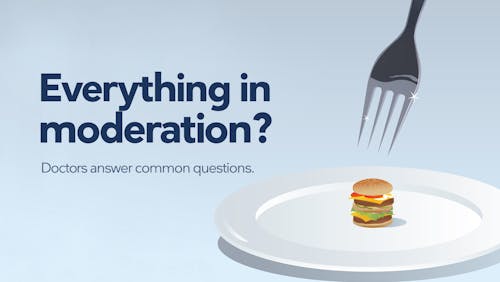The current health crisis and Canada’s food guide

Nutrition is an emotionally-charged topic. It seems as though there are daily online battles about the best way to eat, each side fervently defending their position. News outlets often report findings of studies but are not always accurate. Anyone can offer dietary advice online.
Low-carbohydrate and ketogenic diets have been quite popular in the news lately, and not surprisingly, are stirring up controversy. Why should Canadians pay attention to them, and what does this have to do with our own dietary guidelines? We will address these questions. First, though, we must discuss the nutritional health crisis facing our nation.
Our nutritional crisis
Forty years ago, our government told us to eat less fat and more carbohydrates because they believed dietary fat caused heart disease. Tragically, we have seen an unprecedented and frightening increase in the incidence of type 2 diabetes, obesity, and other nutritional diseases since then. According to the World Health Organization, worldwide obesity has tripled since 1975, and childhood obesity has increased 10-fold in the same time period. In today’s food environment, it is expected that 70% of all Canadian adults will be either overweight or obese by 2040, and a full 5 in 10 children will develop type 2 diabetes in their lifetime. What is even more shocking is that 80% of First Nations children in Canada will develop type 2 diabetes in their lifetime.
This crisis is not just limited to obesity and type 2 diabetes. In 2015, we saw levels of coronary heart disease that were actually projected for 2030, possibly in large part attributable to sugar intake. Coronary heart disease, obesity and type 2 diabetes used to only happen to older adults, after a lifetime of poor nutrition. Now, it is happening at an increasingly younger age. Kids today are being diagnosed with fatty liver disease, type 2 diabetes and metabolic syndrome.
This growing disease epidemic also threatens to bankrupt our healthcare system. According to a recent report by the Heart and Stroke Foundation of Canada, the consumption of sugar-sweetened beverages alone is expected to cost Canada 50 billion dollars over the next 25 years.
Problems with the Food Guide
When we took fat out of our food, food producers replaced it with sugar and refined carbohydrates to make it taste better. We displaced traditional foods with processed food, and ultra-processed foods now make up 48.3 per cent of our daily calories, with children consuming even more, at 57 per cent of their daily calories.
To combat this unsustainable disease burden, doctors and health professionals are re-educating themselves. We formed a social media network of Canadian physicians and allied health professionals, currently 3,500 members and growing, who have gone “back to school” to learn a better way of managing nutritional disease and to advocate for better dietary guidelines. We now believe that the current dietary recommendations are fraught with problems.
Most Canadians would be surprised to learn there was never good evidence supporting the advice to eat less fat and more carbohydrates, and that our Canadian dietary guidelines are closely follow the Dietary Guidelines for Americans. A recent report by the National Academies of Science, Engineering and Medicine raised serious concerns about the scientific rigour of the US Dietary Guidelines, and recommended an overhaul of the process in order to develop trustworthy dietary guidelines. The same concerns and recommendations should apply to the Canadian guidelines.
There have been good summaries written about how and why our dietary guidelines lack scientific rigour; political influence by powerful and persuasive individuals, and competing interests of big food manufacturers, played a major role in establishing the guidelines. The sugar industry, for example, sponsored and influenced scientific research in the 1960s.
Dietary guidelines were also influenced by publication bias. Studies were not published because the results did not support the hypothesis that fat – in particular saturated fat – was the culprit for heart disease. The recovered data of the Minnesota Coronary Experiment showed higher mortality when saturated fat was replaced with vegetable oil, but this was not known until recently, when the original data was discovered and analyzed.
Our nutritional health crisis is fixable
We have experienced devastating unintended consequences of making dietary policy with incomplete or faulty information. But now that we understand that sugar – and not fat – is implicated in most chronic nutritional diseases, we can treat our chronically-ill patients, and hopefully stop others from becoming ill.
Although patients and physicians are taught that illnesses like type 2 diabetes are chronic and progressive, this is only true if the diet remains the same. If people with diabetes reduce their intake of sugar and refined carbohydrates that contributed to the disease in the first place, they may be able to reduce or eliminate their diabetes medications.This is no more restrictive than needing to avoid gluten if you have celiac disease, animal products if you choose to be vegan or vegetarian, or dairy products if you are lactose intolerant. Insulin resistant people with type 2 diabetes are intolerant to carbohydrates, and eating fewer of them improves their health.
Our grandparents had it right by cooking with whole, unprocessed food. A low-carbohydrate, healthy-fat (low-carb) way of eating flies in the face of current guidelines, but this world-wide food revolution is making people well, and can save our healthcare system.
We are advocating for dietary policy change
Health Canada is revising the Food Guide, and we are advocating for guidelines based on rigorous, updated science. We submitted a letter to Health Canada asking for whole-food guidelines, which reflect the current state of evidence on issues like saturated fat, animal products and salt intake. This letter was signed by 717 of our colleagues, some considered world experts in therapeutic nutrition and research.
Many of our suggestions were derived from the sound recommendations outlined in the report of the Standing Senate Committee on Social Affairs, who recently conducted an inquiry into obesity in Canada. This committee concluded “Canada’s dated food guide is no longer effective in providing nutritional guidance to Canadians. Fruit juice, for instance, is presented as a healthy item when it is little more than a soft drink without the bubbles”.
As physicians, we have a responsibility to advocate for change to our dietary guidelines. We have a golden opportunity to change the course of our nation’s health and to become a world leader in nutritional recommendations.
Health Canada published a set of guiding principles regarding the new Food Guide, with many positive changes, such as cautioning against sugar-sweetened beverages and reducing processed food. However, there was still a notable focus on reducing saturated fat, animal-based protein and salt, which is not supported by current evidence. We submitted a rebuttal letter, and were disappointed to receive a standard reply from the Health Minister. We felt they essentially ignored our concerns.
Although Health Canada wishes to caution against saturated fat, the only time we should be making population-wide recommendations to change our intake of a certain food or macronutrient is when we have incontrovertible evidence of its benefit or harm. The evidence surrounding saturated fat is still in a state of flux, with experts unable to completely agree. Most large, good-quality studies show that saturated fat is either neutral or beneficial. But if experts disagree, then we cannot make recommendations, and the guidelines must remain silent.
Rather than advise a reduction in saturated fat, we should follow the lead of the Canadian Heart and Stroke Foundation. It is noteworthy that in 2015, they reviewed the same evidence covered by the US Dietary Guidelines Committee and Health Canada, and instead of an ongoing caution, they judged that a percentile cap on saturated fat was not warranted. Their Position Statement on Saturated Fat in Heart Disease states: “While the discussions and dialogue continue, it is important to note that the overall quality of one’s diet, combined with the types and quantity of food, have more impact on health than any single nutrient such as saturated fat.”
What this means for the general Canadian population
If therapeutic low-carbohydrate diets are so successful in metabolic disease, does this mean everyone should eat this way? Individuals who are lean, metabolically healthy and active can tolerate more carbohydrates than those who are metabolically ill. A carbohydrate-restricted diet works best for individuals with insulin-resistant diseases such as type 2 diabetes, fatty liver, metabolic syndrome, polycystic ovarian syndrome, among others. In fact, some authors suggest that a carbohydrate-restricted diet should be first line therapy in type 2 diabetes.
For the rest of us, a personalized nutritional approach is necessary. But it seems clear, especially according to the recently published large, Canadian led epidemiological PURE study, that the general population should consume less refined carbohydrates and more natural fats than is currently recommended. Focus on whole food and ditch more of the processed, refined products.
Why bother changing the Food Guide?
Why put so much effort into changing the Food Guide when some argue that we don’t follow it anyway? Can’t we just ignore what the government is telling us to eat, when we have already found a better way? In fact, food availability data show that we do actually follow government dietary advice. While most Canadians can choose to ignore the guidelines, there are many populations bound by the Food Guide. School children, hospitalized or institutionalized patients are subject to the rules set out by Health Canada regarding what they can be fed.
It is a problem when patients with diabetes in the hospital are given juice, toast, oatmeal and sugary low-fat yogurt because the Food Guide says the diet must contain 55-60% carbohydrates and limit saturated fat. This raises their already high blood sugar.
It is a problem when kids are given juice in school because the food guide says it is a serving of fruit. Or when schools must choose low-fat dairy products because of “dangerous” levels of saturated fat, when we have repeated studies showing an association between full-fat dairy products and a lower body mass index later in life.
It is also a problem when medical schools teach nutrition principles and concepts that are not supported by science. This is what the students are likely to use to counsel their patients later on.
So not everyone gets to ignore the guidelines.
Grass-roots movement
A grass-roots movement can be incredibly powerful, but change ultimately must come from the top. We must ask our schools to reduce sugar, and our hospitals to remove sugar-sweetened beverages and serve more whole, nutritious food. We expect unbiased dietary advice from our diabetes and obesity organizations, but we must challenge why they receive financial support from food companies that create products implicated in causing these diseases. Finally, we must help our healthcare colleagues learn the power of eating real, whole food with respect to disease prevention and reversal.
The next decade will be very exciting in the world of nutritional science and dietary recommendations, but we cannot wait for policy makers to figure this out. We must act now, and demand that our dietary guidelines be based on sound evidence.
—
Dr. Èvelyne Bourdua-Roy and coauthors: Dr. Barbra Allen Bradshaw, Anatomical Pathologist (Abbotsford, BC), and Dr. Carol Loffelmann, Anesthesiologist (Toronto, ON).
Note: Although the petition is now closed, you can read more about our work on our website at www.changethefoodguide.ca. If you are a Canadian health provider and wish to become involved in our community to collaborate, contact us through the above website.
If you want to learn about using low-carbohydrate nutrition, the Diet Doctor website provides simple explanations, recipes and meal plans, and is the reference most often given to patients by healthcare professionals across Canada.1
More
Do you want to read more by Dr. Èvelyne Bourdua-Roy? Here are her three most popular posts:
Guides
Earlier with Dr. Bourdua-Roy
All earlier posts by Dr. Bourdua-Roy
The dietary guidelines
Low-carb doctors
Low-carb basics
Are you a health care professional? Check out our low carb for doctors site. ↩


















































